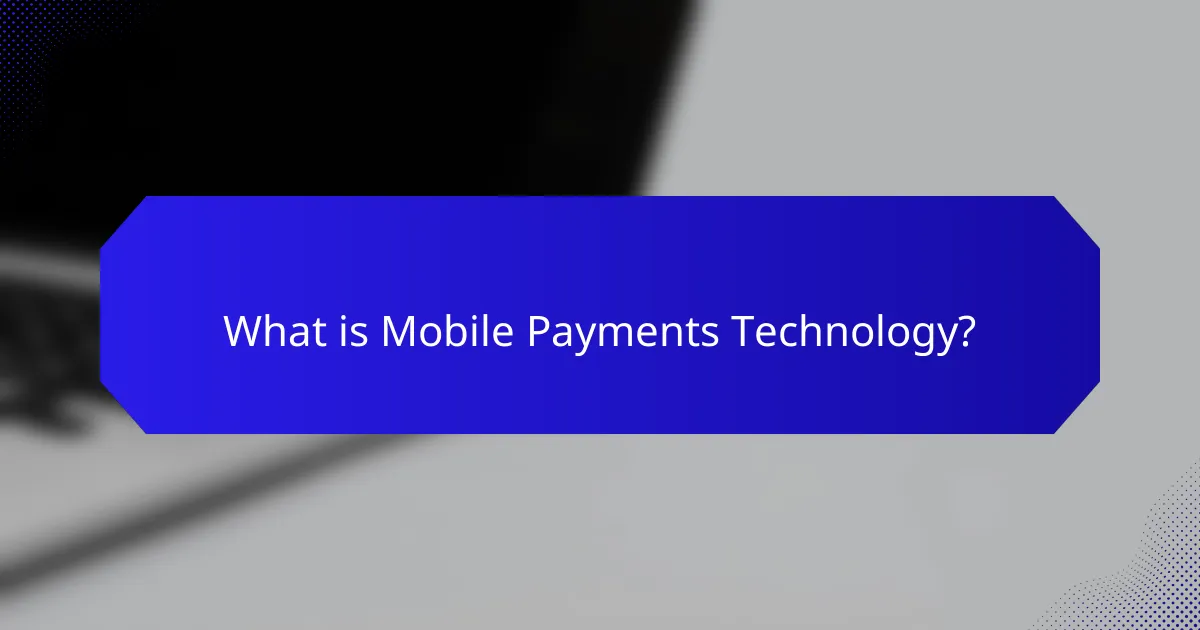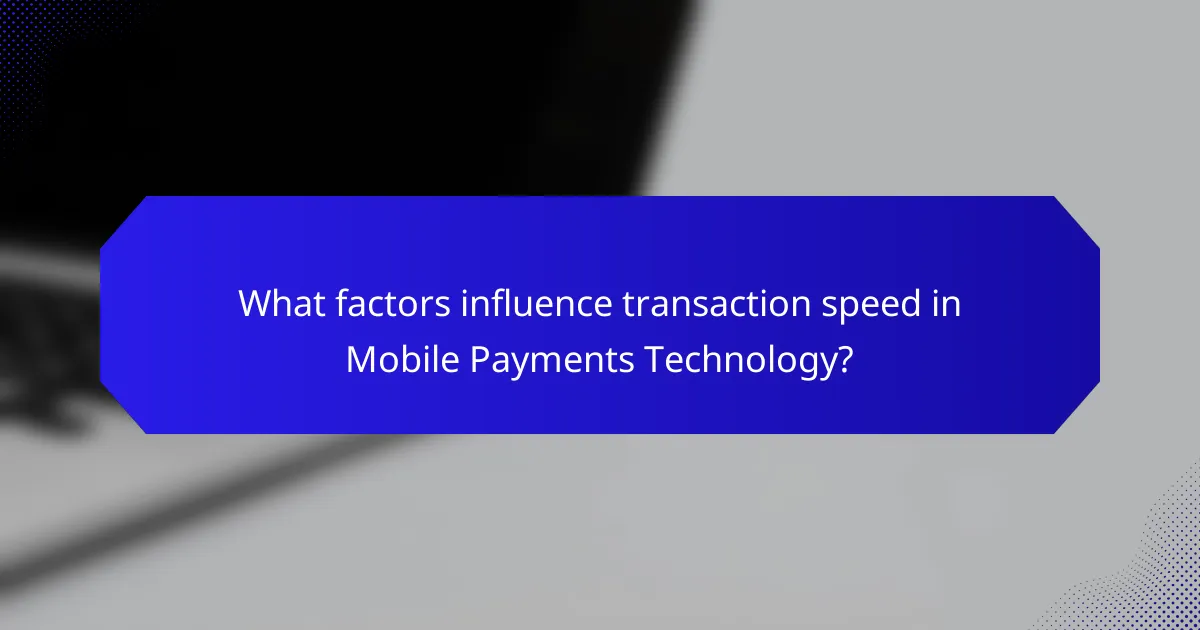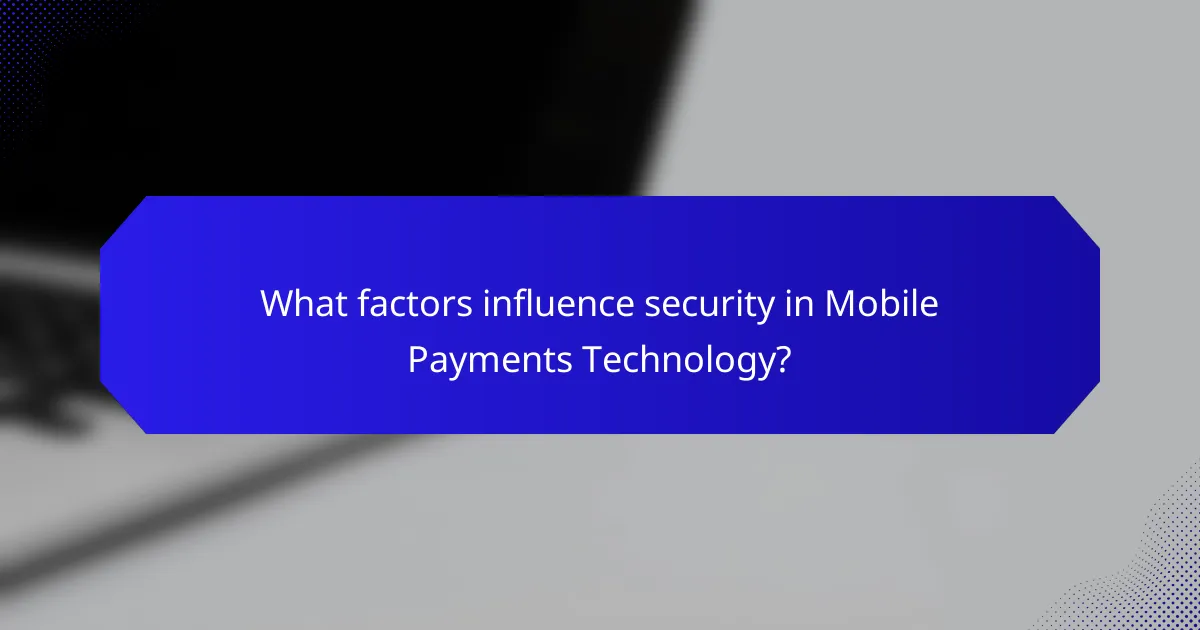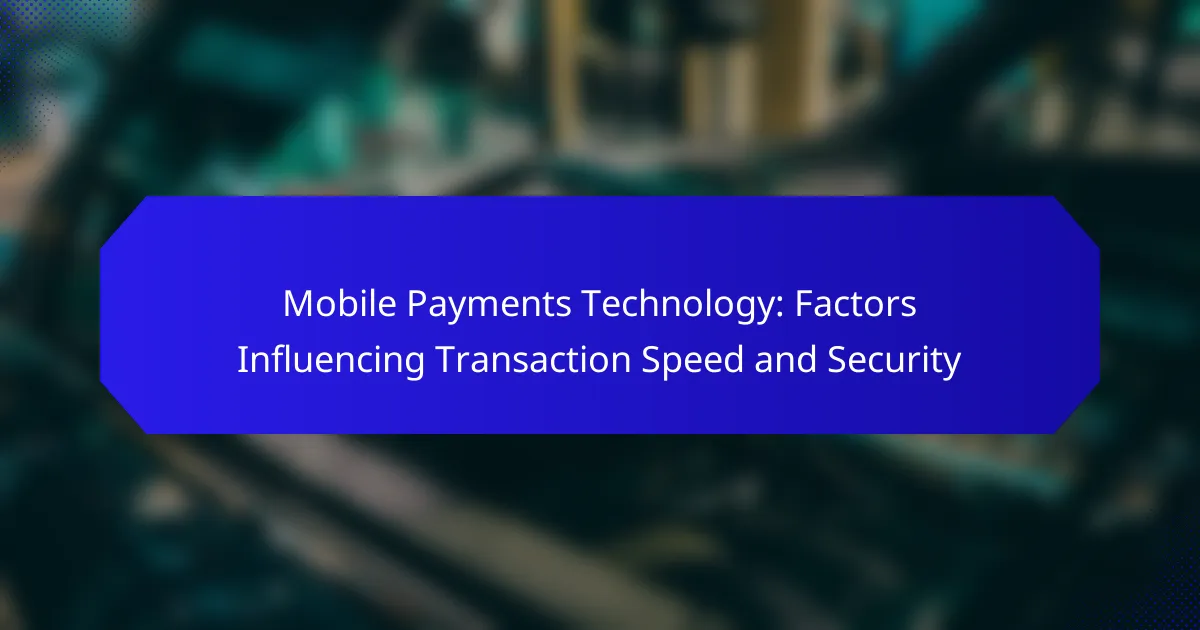Mobile payments technology enables financial transactions through mobile devices such as smartphones, tablets, and smartwatches, utilizing methods like Near Field Communication (NFC), QR codes, and mobile wallets. The article examines the projected growth of mobile payment transaction values, expected to exceed $12 trillion by 2025, driven by consumer adoption and advancements in technology. Key factors influencing transaction speed include network connectivity, payment method efficiency, transaction volume, security protocols, device performance, and payment platform infrastructure. Additionally, the article addresses security aspects of mobile payments, highlighting the importance of encryption, authentication methods, device and network security, regulatory compliance, user education, and continuous software updates to safeguard transactions.

What is Mobile Payments Technology?
Mobile payments technology refers to the use of mobile devices to facilitate financial transactions. This technology enables users to make payments via smartphones, tablets, or smartwatches. It leverages various methods such as Near Field Communication (NFC), QR codes, and mobile wallets. According to Statista, the global mobile payment transaction value is projected to reach over $12 trillion by 2025. This growth reflects increased consumer adoption and technological advancements. Mobile payments enhance convenience and speed for users, allowing for quick transactions without physical cash or cards.
How does Mobile Payments Technology function in everyday transactions?
Mobile payments technology enables transactions through smartphones or other mobile devices. Users typically link their bank accounts or credit cards to mobile payment apps. During a transaction, the user selects the payment method and enters a security code or uses biometric authentication. The app generates a unique transaction code for security. This code is transmitted to the merchant’s payment terminal via NFC or QR code scanning. The terminal processes the payment by communicating with the payment processor. This process usually takes seconds, enhancing transaction speed. According to a report by Statista, mobile payment transactions reached over $1 trillion globally in 2020, indicating widespread adoption and functionality in everyday transactions.
What are the key components of Mobile Payments Technology?
The key components of mobile payments technology include hardware, software, security protocols, and communication methods. Hardware consists of devices like smartphones and payment terminals. Software includes mobile applications and payment processing systems. Security protocols ensure data protection through encryption and authentication methods. Communication methods involve NFC, QR codes, and internet connectivity for transaction processing. These components work together to facilitate secure and efficient mobile transactions.
How do different payment methods integrate with Mobile Payments Technology?
Different payment methods integrate with mobile payments technology through various mechanisms. Credit and debit cards utilize Near Field Communication (NFC) for contactless transactions. This allows users to tap their cards on mobile devices for quick payments. Digital wallets, like Apple Pay and Google Pay, store card information securely. They facilitate transactions by generating unique tokens for each purchase, enhancing security. Bank transfers use QR codes to link accounts directly, allowing users to pay without sharing sensitive information. Additionally, payment processors like PayPal and Venmo offer APIs for seamless integration with apps. This enables users to make payments directly from their accounts within mobile applications. Overall, these integrations enhance user convenience and security in mobile payments.
What are the primary benefits of using Mobile Payments Technology?
Mobile payments technology offers convenience, speed, and enhanced security. Users can make transactions quickly using smartphones, eliminating the need for cash or cards. This method allows for instant payments, reducing transaction times significantly. According to a study by Statista, mobile payments are expected to reach $12 trillion by 2025, highlighting their growing adoption. Enhanced security features, such as biometric authentication, protect user data and reduce fraud risk. Additionally, mobile payments facilitate easier tracking of expenses through digital records. Overall, these benefits contribute to a more efficient and secure payment experience.
How does Mobile Payments Technology enhance user convenience?
Mobile payments technology enhances user convenience by enabling quick and seamless transactions. Users can make payments using their smartphones, eliminating the need for cash or cards. This technology supports contactless payments, allowing transactions with just a tap. It also provides features like digital wallets, which store multiple payment methods in one place. Users benefit from instant transaction notifications, keeping them informed of their spending. Additionally, mobile payments often integrate loyalty programs, making it easier to earn rewards. According to a report by Statista, mobile payment transaction volume is expected to reach $12 trillion by 2024, highlighting its growing adoption and convenience.
What cost savings can businesses achieve through Mobile Payments Technology?
Businesses can achieve significant cost savings through Mobile Payments Technology. This technology reduces transaction fees compared to traditional payment methods. For instance, mobile payments often have lower processing fees, which can save businesses up to 2-3% per transaction. Additionally, mobile payments streamline operations by minimizing the need for cash handling and the associated labor costs.
Mobile payment systems can also decrease the costs related to chargebacks and fraud. According to a study by Juniper Research, mobile payments can reduce fraud-related losses by up to 50%. Furthermore, businesses benefit from faster transaction times, leading to increased customer turnover and higher sales volumes.
The overall efficiency gained from mobile payments can lead to lower overhead costs, enhancing profit margins. As companies adopt this technology, they can expect to see a measurable impact on their bottom line.

What factors influence transaction speed in Mobile Payments Technology?
Transaction speed in mobile payments technology is influenced by several key factors. Network connectivity plays a crucial role; faster internet connections lead to quicker transaction processing. The type of payment method also affects speed; digital wallets usually process transactions faster than traditional credit cards.
Transaction volume during peak times can cause delays; high demand can slow down processing times. Security protocols are necessary but can add time; robust encryption may make transactions safer but slower. Device performance impacts speed; newer devices typically handle transactions more efficiently.
Finally, the payment platform’s infrastructure matters; well-optimized systems can facilitate faster transactions. These factors collectively determine how quickly a mobile payment is completed.
How does network connectivity affect transaction speed?
Network connectivity significantly affects transaction speed in mobile payments. High-quality network connectivity reduces latency and ensures faster data transmission. Poor connectivity can lead to delays in processing transactions. For instance, a 4G network typically offers faster speeds compared to a 3G network. Research shows that latency can increase transaction times by up to 50%. Reliable connections allow for quicker authorization and confirmation of transactions. Conversely, interruptions in connectivity can result in failed transactions or errors. Overall, better network connectivity directly correlates with improved transaction speed in mobile payment systems.
What role does bandwidth play in transaction processing speed?
Bandwidth significantly impacts transaction processing speed. Higher bandwidth allows more data to be transmitted simultaneously. This reduces the time required for transactions to be completed. For instance, mobile payment systems rely on internet connectivity. A bandwidth of 10 Mbps can support multiple transactions without delay. Conversely, low bandwidth may cause bottlenecks. This results in slower processing times and potential transaction failures. Studies show that increased bandwidth correlates with improved transaction efficiency. Thus, bandwidth is crucial for optimizing mobile payment speeds.
How do latency issues impact user experience in mobile payments?
Latency issues significantly degrade user experience in mobile payments. High latency leads to delays in transaction processing. Users may experience frustration due to slow response times. This can result in abandoned transactions. According to a study by the Boston Consulting Group, a 1-second delay can reduce customer satisfaction by up to 16%. Users expect instant transactions in mobile payments. Delays can also erode trust in the payment system. Consistent latency issues can drive users to alternative payment methods. Overall, latency directly impacts user satisfaction and retention in mobile payments.
What technological advancements have improved transaction speed?
Blockchain technology has significantly improved transaction speed. It allows for decentralized transactions that bypass traditional banking processes. This can reduce transaction times to mere seconds. Additionally, advancements in payment processing systems, such as Near Field Communication (NFC), enable quick tap-to-pay transactions. Contactless payments have also become more widespread, enhancing speed and convenience. Furthermore, improvements in internet connectivity, like 5G technology, facilitate faster data transmission. These advancements collectively contribute to a more efficient payment ecosystem.
How do faster processing chips contribute to mobile payment efficiency?
Faster processing chips enhance mobile payment efficiency by reducing transaction times. They enable quicker data processing, which accelerates transaction approvals. This speed minimizes wait times for users during payments. Enhanced processing power allows for better encryption and security measures. Stronger security features protect sensitive data without slowing down transactions. According to a study by Juniper Research, faster chips can improve transaction speeds by up to 30%. This efficiency leads to higher customer satisfaction and increased usage of mobile payment systems.
What impact do software optimizations have on transaction speed?
Software optimizations significantly enhance transaction speed in mobile payment systems. These optimizations streamline processing algorithms and reduce latency. Improved code efficiency allows for quicker execution of transaction requests. Enhancements in data handling minimize bottlenecks during peak usage. For instance, optimizing network protocols can decrease the time taken for data transmission. Studies show that optimized systems can process transactions up to 50% faster. This speed increase directly influences user satisfaction and transaction success rates.

What factors influence security in Mobile Payments Technology?
Security in mobile payments technology is influenced by several factors. These include encryption protocols, which protect data during transmission. Strong authentication methods, such as biometrics and two-factor authentication, enhance user verification. Device security also plays a crucial role; operating system vulnerabilities can expose sensitive information. Network security is vital, as unsecured Wi-Fi connections can lead to data breaches. Compliance with regulatory standards, like PCI DSS, ensures that payment systems meet security requirements. User awareness and education about phishing attacks and secure practices further bolster security measures. Lastly, continuous monitoring and updates to software can mitigate emerging threats.
How do encryption methods safeguard mobile transactions?
Encryption methods safeguard mobile transactions by converting sensitive data into a coded format. This process ensures that only authorized parties can access and read the information. Common encryption techniques include SSL/TLS protocols, which secure data in transit. These protocols create a secure channel between the user’s device and the payment server.
Additionally, end-to-end encryption ensures that only the sender and receiver can decrypt the messages. This prevents interception by malicious actors during the transaction process. According to a report by the Ponemon Institute, 60% of organizations that use encryption have experienced fewer data breaches. This statistic highlights the effectiveness of encryption in protecting mobile transactions.
What types of encryption are commonly used in mobile payments?
Common types of encryption used in mobile payments include AES, RSA, and TLS. AES, or Advanced Encryption Standard, is widely utilized for securing data at rest and in transit. It offers strong encryption through symmetric key algorithms. RSA, or Rivest-Shamir-Adleman, is often used for secure key exchange in mobile transactions. This asymmetric encryption method relies on the mathematical difficulty of factoring large integers. TLS, or Transport Layer Security, protects data transmitted over the internet. It ensures confidentiality and integrity during mobile payment transactions. These encryption methods are essential for safeguarding sensitive financial information and maintaining user trust in mobile payment systems.
How does encryption impact transaction speed and security balance?
Encryption enhances transaction security but can slow down processing speed. Strong encryption algorithms require more computational power. This increases the time needed for data encryption and decryption. For example, AES encryption can add milliseconds to transaction times. However, the trade-off is improved data protection against fraud and unauthorized access. A study by the National Institute of Standards and Technology shows that secure transactions are crucial for consumer trust. Thus, while encryption may reduce speed, it significantly bolsters overall security.
What role does user authentication play in mobile payment security?
User authentication is crucial for mobile payment security. It verifies the identity of users before allowing transactions. Strong authentication methods, such as biometrics and two-factor authentication, reduce the risk of unauthorized access. According to a study by the Ponemon Institute, 70% of data breaches involve weak or stolen credentials. This highlights the importance of robust user authentication in preventing fraud. Additionally, secure authentication enhances user trust in mobile payment systems. Trust leads to increased adoption and usage of mobile payment platforms. Overall, effective user authentication is a foundational element of mobile payment security.
What are the most effective authentication methods for mobile payments?
Biometric authentication, such as fingerprint and [censured] recognition, is among the most effective methods for mobile payments. These methods provide high security and convenience for users. According to a study by Biometric Technology Today, biometric systems reduce fraud by up to 99%. Additionally, two-factor authentication (2FA) enhances security by requiring a second form of verification. This can include SMS codes or authentication apps. Research from the Journal of Cybersecurity indicates that 2FA can prevent unauthorized access in 90% of cases. Lastly, tokenization protects sensitive data by replacing it with a unique identifier. This method minimizes the risk of data breaches during transactions.
How can biometric authentication enhance transaction security?
Biometric authentication enhances transaction security by using unique physiological traits to verify identity. This method includes fingerprints, [censured] recognition, and iris scans. Each biometric trait is difficult to replicate or forge, making unauthorized access challenging. According to a study by the National Institute of Standards and Technology, biometric systems can achieve a false acceptance rate as low as 0.001%. This high level of accuracy reduces the risk of fraud during transactions. Additionally, biometric authentication often requires user presence, further ensuring that only legitimate users can complete transactions. As a result, biometric methods significantly strengthen security measures in mobile payments.
What best practices should users follow to ensure secure mobile payments?
Users should enable two-factor authentication for mobile payments. This adds an extra layer of security beyond just a password. Regularly updating mobile payment apps is also essential. Updates often include security patches that protect against vulnerabilities. Users should avoid public Wi-Fi when making payments. Public networks can expose sensitive information to hackers. Using strong, unique passwords for payment apps is crucial. Weak passwords can be easily compromised. Users should monitor their bank statements regularly. This helps in identifying unauthorized transactions quickly. Lastly, users should only download payment apps from official app stores. This reduces the risk of downloading malicious software.
Mobile payments technology refers to the use of mobile devices for financial transactions, incorporating methods like NFC, QR codes, and mobile wallets. The article explores how this technology functions in everyday transactions, highlighting key components such as hardware, software, and security protocols. It also discusses various payment methods, benefits for users and businesses, and factors influencing transaction speed and security, including network connectivity and encryption methods. Additionally, it outlines best practices for users to ensure secure mobile payments, emphasizing the importance of authentication and regular updates.
